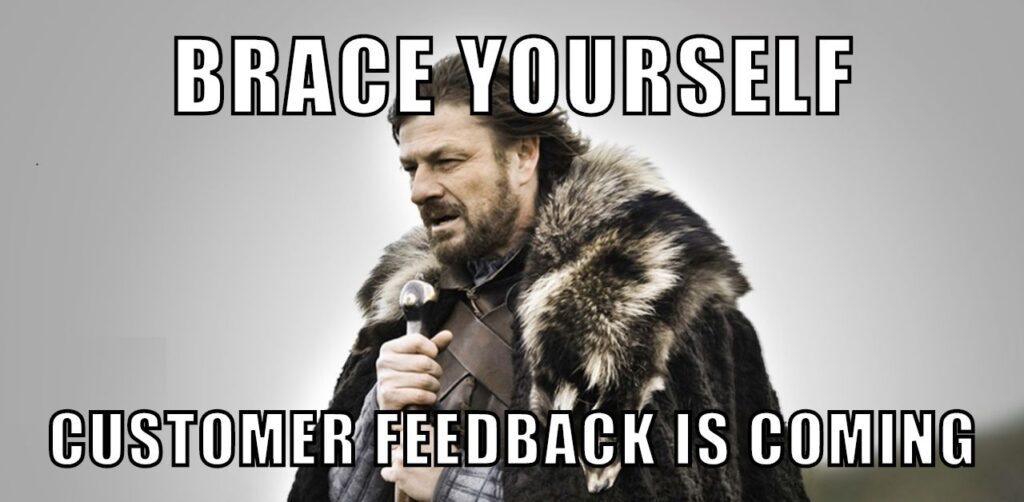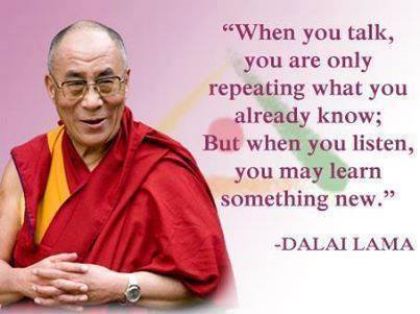Don’t scale sales before you have product market fit! For a mature company, this is expensive but for a startup it is lethal. Let’s dive deeps into why you must nail down the customer requirements to be successful in business.

I’ll challenge you right away. How many customers did you talk to this week? No excuses. I hope it is a pretty high number and that you had quality conversations. Otherwise, you are probably building or selling the wrong thing.
Let me explain why this is so important.
The story about the startup that didn’t know their customer requirements
“But they need our product! They just don’t know it yet. We need to reach more people faster and be better at convincing them about the greatness of our offering. And then surely revenue will come.”
I looked at the startup CEO and tried to hide my frustration. She just wasn’t listening to what I was saying. I had met her a couple of weeks earlier with some other experts to advise changing the strategic direction of her company.
She was convinced they could pivot the audience from enterprise customers (large mature organizations) to SMEs (Small / Medium Enterprises). I was not. But what was even worse was there was no proof to back this pivot up.
We had been going at it for 40 minutes or so. I tried over and over to lead her down the path of what she actually knew about the requirements of their new potential customers but over and over the conversation turned into a fiery speech about how great the product was. Even today, I’m still not sure if she was trying to convince me or herself.
There’s a time to sell and a time to listen
Talking to your prospective customers to learn what problems and needs they have are very different from selling your product. Think about it. It’s about the direction of the information flow.
In the story above the CEO had already decided what the customers needed based on the product they already had built for another target group. She was under pressure to show traction, and the best traction is revenue. Every conversation she was having became about convincing the other side of the table of the greatness of the product.
This is why great salespeople usually are the worst person to put to the task of researching customer needs and requirements. The goal of a sales conversation is to drive the prospect closer to placing an order. The goal of a research conversation is to validate a hypothesis of how the customer requirements.

We need to mold the product into something that fits the customer’s requirements. Not mold the customers to fit our product/idea. This takes patience, listening skills, and empathy.
Before product market fit, we shouldn’t market our product aggressively
There is nothing to scale. This is the time to craft the experience into something that is so good that it will almost sell itself on recommendations. Once you are there, you can start selling it.

So what happened to the startup? As far as I know, they are still trying to polish the marketing message to make the sales take off. This is without having nailed down the core requirements of the customers. Revenue has not yet manifested.
But why is this happening over and over in startups as well as in mature companies?
It’s human to be reluctant to put our idea to the test
What if we are wrong? What if the idea we have spent so much time thinking about and working on does not work out as we thought? We often prefer to act like kids pulling a blanket over our heads with a flashlight in hand fantasying about all the wonders outside of our sheltered world.
“Ignorance is bliss“
Thomas Gray
We put so much of our personal stake in the ideas that we just don’t want to look at the facts. “Ignorance is bliss as Thomas Gray put it in his “Ode on a Distant Prospect of Eton College”, but it’s true only until reality hits you like a bus at full speed. Better to be wrong early and adjust course, or throw it away altogether.
When I was part of the Antler program, a startup builder, a couple of years ago we were to go out and talk to 50 people in our space to get feedback on our idea. Once we were there we were told to get to 200. Don’t sell the idea, listen, we were told.

Paul Graham coached Brian Chesky when he was building AirBnB at Y-Combinator. He told him to relocate to where his customers were. And talk to every single one of them. You can check out more about this story in the article “How Design Thinking Transformed Airbnb from a Failing Startup to a Billion Dollar Business”.
But talking to every customer doesn’t scale some might say. And only startups that can scale takes off for real. But remember, scaling comes after we find product-market fit. And it might be very likely that early on is the only time you have time to talk to every single customer.
But I don’t need to talk to people to know your customer requirements, the numbers will tell the truth (False!)
Numbers don’t lie people say. And I agree. But do we understand what the numbers are saying? Maybe we are missing the point or asking the wrong questions. Numbers can only give us raw data, it’s our job to translate the data into useful information.

Tracking product usage, click-through rates on marketing campaigns, conversion numbers from free to premium accounts, and page visitor statistics are all great tools. But it’s just one piece of the puzzle to understanding our customers. It’s not the whole truth. It is what product professionals call quantitative feedback.
We need to complement quantitative feedback with qualitative feedback to understand the whole picture. They both complete each other.
- Quantitative – Mainly answers the question of WHAT the customers do
- Qualitative – Mainly answers the question of WHY the customers do what they do
If we are not getting quantitative feedback from customers or users at least bi-weekly we are not iterating fast enough. This is true for startups as well as mature organizations. A faster iteration cycle than 1 week is preferred and I’ve seen it done. It is possible even though many organizations have lead times of 6 months from idea to insight.

But what are the actual steps we need to go through then to complete an iteration cycle?
The 5 steps to know your customer requirements which take you from hypothesis to insight
Here is a brief outline of the steps:
Step 1: Understand why you are talking to your customers
Think like a scientist. What are we trying to prove? We should write down our purpose for the iteration. Remember that finding out customer requirements and drivers is not the same as finding out if they understand your design/usability/message.
Step 2: Design your questions to help you reach insight into customer requirements
The outcome is determined by the quality of the conversations we have. And we will drive the conversations as an interview so we must prepare questions.

Start with your purpose from Step 1, and write an assumption. Write it as a hypothesis. Example:
“We believe that our customers will understand our product offering from our new website design. They will be able to mention the offering and our 2 USPs after looking at the site for 5 seconds.”
Example questions to ask in such interviews could be:
- “Describe with your own words the message of the site.”
- “Did the design inspire confidence and professionalism?”
The questions must not be leading the interview subject down a path of thinking. Also note that in the example above we would not learn much about if people would like to use our product, the focus is on usability/design and if the message is understandable.
Step 3: Decide your target audience to talk to
First, decide about the type of person you want to talk to. They should share characteristics and requirements with your target audience. Create what Product / UX professionals call a persona.
The number of people we need to talk to depends on the purpose of the iteration. Researchers in the article “A mathematical model of the finding of usability problems” show that as few as 5 are enough to understand 85% of the usability issues of our product.

However, if we want to understand customers’ requirements we need to talk to more people. Here there is no clear-cut rule. It depends on the diversity of our target audience as well as the scope of your questions. It is outlined in the article “How Many Participants for a UX Interview?” that we need anywhere between 5 and 50. Or even more.
Now comes the hard part. At least I think so. We need to bring out our interpersonal skills and approach people to talk to.
Step 4: Find actual people and go listen to them
We need to find interview subjects. Unbiased people who know nothing about our product. Don’t use your mom, partner, or best friend!

We can find people on the street, amongst our neighbors that don’t know our product already, or in forums or groups online. But it is quite time-consuming to chase people down this way and personally I find it quite daunting walking up to strangers on the street to ask for 10 minutes of their time. I feel like a salesperson and a lot of people just ignore me. I never got used to the feeling of rejection.
On top of that, it could be the case we are looking for feedback on something very specific, like how physicians find the usability of the new interface of our x-ray machine prototype. You will have to approach a lot of people on the street before you run into people that fit this profile.
Or we can also use a service like FeedbackFrog. They help us put together a list of willing test subjects and support us through the process. These subjects are tailored to your target group/persona which can sometimes be hard to find.

It will save us the emotional pain of rejections on the street. It will also save time and energy by avoiding the common mistakes mentioned in the PDF you can download through the banner at the top of the article. And who knows, the people we get to talk to might very well become our customers.
For transparency’s sake, you should know I am an investor in FeedbackFrog.
Step 5: Use the results to synthesize conclusions and adjust your future activities
Now, all we have to do is look at our results and compare them to the assumption and hypotheses we wrote before we did the interviews. I bet there are good insights coming from this. Use this as input and start the cycle over again!
Conclusion
We should not scale sales or build a polished product unless we have proof of there is a real need from customers. Business is not about forcefully convincing people to buy our product but to make them want it.
We must make sure we have regular conversations with our customers. Conversations about their requirements and situation. These conversations are not sales calls.
If we are not talking to customers or end-users at least bi-weekly about their needs we are doing something wrong.
Make sure to use a structured process when having conversations. Test a hypothesis with every iteration and consider using a service such as FeedbackFrog to save time and energy to get in contact with people from your target group.







